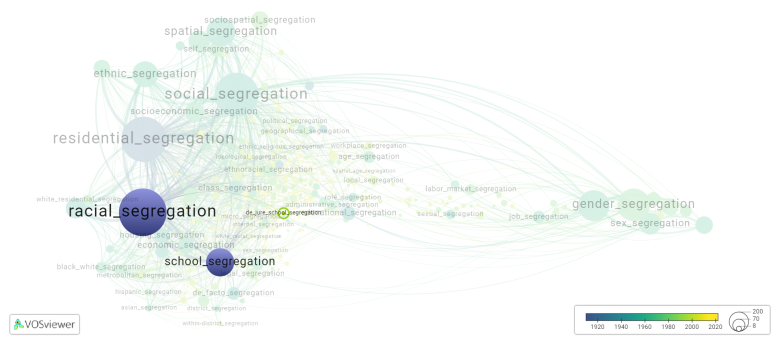De jure school segregation
Date and country of first publication[1]
2004
United States
Definition
De jure school segregation refers to the segregation of students in schools that is mandated by law or official policy. This type of segregation was prevalent in the United States during the period of legalized segregation known as the Jim Crow era, when laws were implemented to separate white and black students in schools. De jure school segregation was ruled unconstitutional by the Supreme Court in the landmark case Brown v. Board of Education in 1954.
See also
Related segregation forms
De jure school segregation is frequently discussed in the literature with the following segregation forms:
school segregation, racial segregation

This visualization is based on the study The Multidisciplinary Landscape of Segregation Research.
For the complete network of interrelated segregation forms, please refer to:
References
Notes
- ↑ Date and country of first publication as informed by the Scopus database (December 2023).
De jure school segregation appears in the following literature
Ramos L.Y. (2004). Dismantling segregation together: Interconnections between the méndez v. westminster (1946) and brown v. board of education (1954) school segregation cases. Equity and Excellence in Education, 37(3), 247-254. https://doi.org/10.1080/10665680490491560
Scott R. (2005). Law, social science, federal and state agencies, resurgence of Tabula Rasa, and perpetuation of racial problems. Mankind Quarterly, 46(1), 81-98. Ulster Institute for Social Research.https://doi.org/
Simpson G.E., Milton Yinger J. (2017). Techniques for Reducing Prejudice: Changing the Situation. Psychology and Race, 145-174. Taylor and Francis.https://doi.org/10.4324/9781315127668-8
Jean-Pierre J. (2021). How African Nova Scotians envision culturally relevant and sustaining pedagogy as civic repair. British Journal of Sociology of Education, 42(8), 1153-1171. Routledge.https://doi.org/10.1080/01425692.2021.1981247
